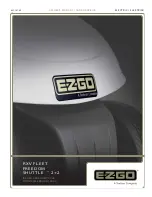B
2
Repair and Service Manual
GENERAL INFORMATION AND ROUTINE MAINTENANCE
Read all of SAFETY and this section before attempting any procedure. Pay particular attention to Notices, Cautions, Warnings and Dangers.
699322
injury should an unforeseen dangerous situation occur.
Always use the appropriate tools listed in the tool list and
wear approved safety equipment.
Before a new vehicle is put into operation, it is recom-
mended the items shown in the INITIAL SERVICE
CHART be performed.
Fig. 2 Initial Service Chart
FUEL
To decrease the risk
of severe injury
or death from improper fuel han-
dling:
Do not smoke near the fuel tank.
Do not add fuel near open flame or electrical items
that can cause a spark.
Always handle gasoline in a well ventilated area.
Always wear eye protection to protect against
splashed fuel and fuel vapors.
Inspect the fuel cap, tank and other components for
leaks or damage that can cause a hazardous condi-
tion.
Oxygenated or reformulated gaso-
line, is mixed with alcohols or
ethers. Excessive amounts of these
blends can damage the fuel system or cause perfor-
mance problems. If any operating problems occur,
use gasoline with a lower percentage of alcohol or
ether.
Use clean regular grade unleaded fuel. The Ethanol
blend fuel up to 10% is permitted.
Do not
use gasoline that contains methanol.
High altitude or heavy use/load applications can benefit
from higher octane gasoline.
FUEL TANK
The fuel tank is located under the seat, on the passenger
side of the vehicle. Fill tank with fresh, clean, automotive
grade, unleaded, 87 octane (minimum) gasoline. Heavy
use/load applications may benefit from higher octane
gasoline. The fuel tank is designed to allow for fuel
expansion and does not require space below the bottom
of the filler neck.
Fig. 3 Fuel Tank
When refueling, inspect the fuel
tank cap for leaks or breaks in the
housing that could result in fuel
spillage.
To prevent a possible explosion, do not smoke near
the fuel tank or refuel near open fire or electrical
items which could produce a spark.
Always wear safety glasses while refueling to pre-
vent possible injury from gasoline or gasoline
vapor.
Do not handle fuel in an area that is not adequately
ventilated. Do not permit anyone to smoke in an
area where vehicles are being fueled.
TOWING
To prevent personal injury, do not
ride on vehicle being towed. Do not
attempt to tow the vehicle with
ropes, chains or any device other than a factory
approved tow bar. Towing a disabled vehicle can be
dangerous and requires extra caution. Attempting to
tow with devices other than an approved tow bar
may result in severe personal injury or death.
Place direction selector in neutral.
The neutral lock should be used
to lock the direction selector in
position. This will reduce the possibility of it moving
into ‘F’ (for -ward) or ‘R’ (reverse) while being
towed, causing possible damage to the rear axle.
Use extra caution when towing vehicle. Do not tow a
single vehicle at speeds in excess of 12 mph (19
kph). Towing the vehicle at above recommended
speed may result in personal injury and/or damage
to vehicle and other property.
ITEM SERVICE
OPERATION
Battery Charge
battery
Seats
Remove protective plastic covering
Brakes
Check operation and adjust if necessary
Establish new vehicle braking distance
Tires Check
pressure
Tire size : 20X10X10 - (26-32 Psi)
: 10X7 - (18 Psi)
Fuel
Fill tank with correct fuel
Engine
Check oil level
Содержание LS2 2020
Страница 1: ...REPAIR AND SERVICE MANUAL 699322 A Issued May 2019 653635 B...
Страница 16: ...B xiv Repair and Service Manual TABLE OF CONTENTS 655827...
Страница 17: ...B TABLE OF CONTENTS xv Repair and Service Manual 655827...
Страница 18: ...B xvi Repair and Service Manual TABLE OF CONTENTS 655827...





